Indiana-sleep-soc-presentation2012
advertisement
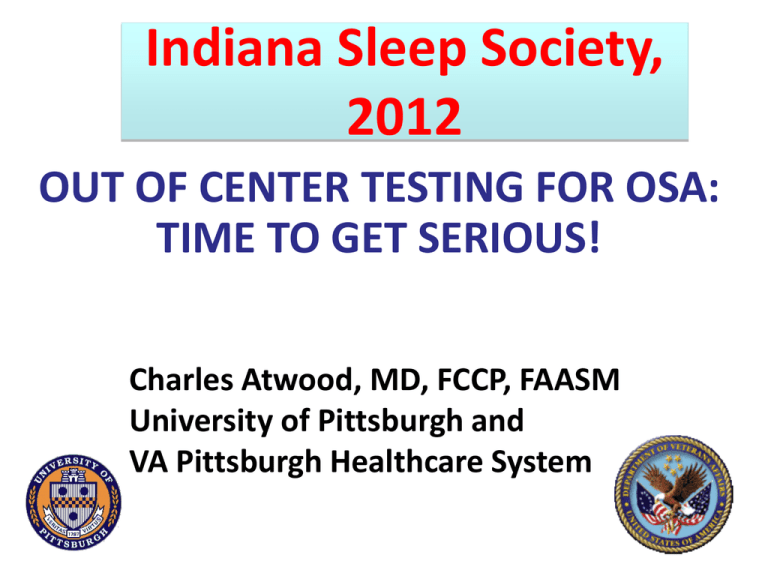
Indiana Sleep Society, 2012 OUT OF CENTER TESTING FOR OSA: TIME TO GET SERIOUS! Charles Atwood, MD, FCCP, FAASM University of Pittsburgh and VA Pittsburgh Healthcare System DISCLOSURES • Commercial research support – Philips-Respironics, Resmed, Embla, Vapotherm • Federal support – VA HSR&D, NIH • Consultant – Care Core national Presentation • Overview of home sleep apnea testing (HSAT) – Classification – Types of monitors – Data supporting its use • Practical lessons about how to make this work – Equipment – Reimbursement – Pittfalls to avoid Objectives 1. Take the mystery and fear out of HSAT 2. Improve your understanding about HSAT on an intellectual level and on a practical level 3. Equip you with the tools you need to successfully add this to your practice The Present The current state of HSAT “May you live in interesting times” -Ancient Chinese curse Home Sleep Apnea Testing Talking about…what? • • • • Portable monitoring – conventional term Ambulatory monitoring – conventional Home sleep testing (HST) – CMS term Home sleep apnea testing (HSAT) – my preferred term • Out of center testing (OCT) – AASM term Why is HSAT so controversial? • Threat to polysomnography • Sleep medicine is quite young as an organized field and vulnerable – Need significant clinical $$ to support it – PSAT threatens PSG revenue • Many are satisfied with status quo Some current controversies/opportunities in Sleep Apnea Medicine • Integrating HSAT into clinical practice • Integrating adherence-usage data into clinical practice • Developing a chronic disease mindset about sleep apnea • DME in the sleep lab Who wants HSAT? • • • • • • • CMS (medicare/medicaid) CPAP manufacturers Capitated health plans Homecare Some physicians Other Insurers Patients and patient advocacy groups Who is opposed to HSAT? • Some sleep lab owners • Physicians who read a lot of PSGs • Sleep laboratory technologists? Cardiovascular Consequences of Sleep-Disordered Breathing Report of a Workshop From the National Center on Sleep Disorders Research and the National Heart, Lung, and Blood Institute Basic Science Cellular / molecular studies Mouse models Pathway studies for humans Clinical Epidemiology Develop new tools for Sleep Disordered Breathing & Cardiovascular Disease population screening Prospective cohort studies Incorporation of SDB / Sleep Deprivation in ongoing CV cohort studies Clinical Therapeutic Studies • High – risk patient subsets • Development of new treatment approaches Circulation 2004 109:951-957 Institute of Medicine Report, 2006 What is needed? • Expand awareness among health care professionals through education and training. • Develop and validate new and existing diagnostic and therapeutic technologies. Why is HSAT Important? • Need for “mainstreaming” of sleep medicine – lack of options for tools hinders this • Variable access to care • Fosters chronic disease model approach to care • May save money Current Coverage of HSAT • CMS Medicare Administrative Carriers (MACS) define HSAT in the context of CPAP therapy… • CPAP can be prescribed if… OSA is diagnosed based on a clinical evaluation and one of the following – Full PSG – HSAT level II, III, IV with 3 channels Classification of HSAT Equipment • Level 1 – Full in lab PSG • Level 2 – Miniaturized full PSG in a non-lab setting • Level 3 – Cardiopulmonary studies • Oximetry, airflow, effort, HR • Level 4 – 1, 2 or 3 channels Type 4 with 3 channels • One channel must be airflow • Other channels typically are pulse-ox and EKG/HR The Past How we got to this current state Summary of Literature 1990-2006 Single site studies; small samples Homogenous cohorts – middleaged male snorers Variable rigor of study design; frequently focused on highest risk subjects All focused on “new portable monitor” vs. PSG approach 2006 Expand awareness through education and training. Develop and diagnostic and therapeutic technologies 2007-Present Realization that home testing is here to stay and evidence is neither perfect nor dismal Outcomes-oriented studies replace “comparison-of-device” studies To get your own copy, go to www.arhq.gov and search under completed technology assessments, 2007 Ability of type III monitors in the home setting to identify AHI suggestive of OSAHS in laboratory-based polysomnography Neg LR < 0.1 Pos LR >10 Trikalinos et al, AHRQ, 07 Recent Research Update Review of recent HSAT studies Recent studies in HSAT • N = 65 • Highly selected group high risk for OSA • Compared autocpap after home test vs. sleep lab approach Mulgrew et al, Ann Int Med, 2007 Recent studies in HSAT N = 106 Berry et al, Sleep, 2008 Recent Studies of HSAT • Single site study from Saskatchewan • Randomized order of testing but all subjects had full PSG and home testing • N=89 • Home APAP for 1 week • 4 week follow-up • Found no difference in outcomes for home vs. lab therapy Skomro et al, Chest, 2010 Veterans Sleep Apnea Treatment Trial (VSATT) • OSA is common in VA • VA is ill-equipped to manage OSA in the conventional way – Few labs relative to numbers of patients – Geographic disparities for access • Necessary to think creatively to solve this problem • Believed that home dx and treatment MUST be a part of this Kuna et al, AJRCCM, May, 2011 VSATT goals 1. Determine if home diagnosis of OSA followed by autoCPAP for OSA positive patients has no worse an outcome compared to patients who are diagnosed and have CPAP started in the sleep laboratory We predicted equivalent outcomes VSATT goals 2. Compare the differences in cost and qualityadjusted life years saved (QALYS) between home and in-lab testing by estimation of the ratio of the cost per QALYS saved. We predict lower costs with equivalent outcomes VSATT – Equipment • Diagnostic HSAT – Embletta by Embla • AutoCPAP – Respironics REMstar auto Inclusion and Exclusion Criteria Inclusion criteria: • Patients referred for a sleep evaluation for suspected sleep apnea • Age 18 years • Living within 90 miles of the sleep center Exclusion criteria: • Unable or unwilling to provide informed written consent • Inability to complete the Assessment Battery • Lack of telephone access or inability to return for follow-up testing. • Prior sleep evaluations, OSA treatment, or other sleep disorder • A clinically unstable chronic medical condition as defined by a new diagnosis or change in medical management in the previous 3 months of cardiac disease, thyroid disease, diabetes, depression or psychosis, cirrhosis, or recently diagnosed cancer • Individuals on long term oxygen therapy or requiring BIPAP • Rotating shift work or irregular work schedules over the last 6 months • Suspected or confirmed to be pregnant VSATT study design Baseline Assessment and Randomization (n=296) Home sleep study (n=139) In-lab PSG (n=35) Home autoCPAP titration (n=119) Non-OSA (n=9) CPAP set-up (n=110) CPAP set-up (n=113) In-lab PSG (n=18) One month FU (n=92) One month FU (n=103) Three month FU (n=86) Three month FU (n=96) In-lab PSG (n=141) AHI < 15 (n=23) Clinic F/U Non-OSA (n=9) Dx’ic PSG (n=99) Split PSG (n=42) CPAP PSG (n=84) VSATT endpoints and covariates General outcome Cost-effectiveness • • • • • • • • • • HUI 2 • EuroQol 5D • Healthcare costs – VA and non-VA FOSQ Adherence - smart cards ESS PVT SF-12 CESD MAP Meds Comorbidities Baseline characteristics in all subjects initiated on CPAP Home Testing (n=113) In-Lab Testing (n=110) Factor Mean ± SD Mean ± SD P-value Age (yrs) 55.1 ± 10.3 51.8 ± 10.4 0.02 Height (in) 69.3 ± 3.5 69.9 ± 3.3 0.30 Weight (lb) 238.9 ± 53.1 237.7 ± 42.4 0.85 BMI (kg/m2) 35.0 ± 7.5 34.2 ± 5.2 0.34 FOSQ total score 15.0 ± 3.2 14.7 ± 2.9 0.55 12 ± 5 13 ± 5 0.21 PVT (transformed lapses) 3.8 ± 2.6* 4.3 ± 3,7 0.83 CES-D 23.3 ± 7.8 25.0 ± 8.8 0.13 SF-12 physical score† 36.7 ± 10.9 38.2 ± 10.2 0.29 SF-12 mental health score 44.4 ± 10.8 41.1 ± 10.7 0.02 ESS score * n=111; † n=109 FOS Mean (SD) of FOSQ total score by treatment group 5 from baseline to month 3Figure in all1a subjects initiated on CPAP FOSQ Total Score Mean and SD by Treatment Group in the mITT Efficacy Evaluable Cohorts 0 Before and After the Three Month Treatment Period Baseline Month 3 Time 25 Home (N=105) In-Lab (N=96) Mean (SD) FOSQ Total Score 20 15 10 5 0 Baseline Time Month 3 Mean CPAP adherence from baseline to month 3 in all subjects initiated on CPAP Endpoint Mean CPAP (hours/day) Home adjusted mean change1 (n=113) In-Lab adjusted mean change1 (n=110) 3.42 2.99 Adjusted P-value2 difference in mean changes (SE)1 0.42 (0.32) 0.180 Lower bound of 90% CI for difference in mean changes - 0.10 1 Adjusted mean changes and adjusted differences in mean changes were estimated as site-total-sample-size weighted values controlling. 2 P-value from Type II sum of squares estimated by way of analysis of covariance. To produce site weighted comparisons the ANCOVA model included main effects for type of study (home vs in-lab) and site. Kuna et al, AJRCCM, May, 2011 Conclusion Functional improvement with CPAP for OSA is not worse when treated in the home setting vs. the sleep laboratory Implication Home based OSA diagnosis and initiation of CPAP is effective in treating OSA The future Practical applications of HSAT “Gap” Between Evidence and Practice • Reimbursement • Vested interest in the status quo • Lack of training HOME OSA TESTING Evidence HOME OSA TESTING Practice Practical Application of HSAT • Pick one system and get to know it well • Patient selection – pre-select or all comers? • Considerations – Who will teach patients how to use it? – How will patients return it? – Who will score it? Practical Considerations • Lost equipment • Turn around time – want it short • Technically inadequate studies – expect 1015% • What to do with negative studies • Contracting with private insurance companies A few recommendations… • Consider using mailers – UPS or Fedex; tracking codes – May not be a reimburseable expense but you can get your monitor back quickly • Purchase or develop video to explain hook up for patient –can be time saving Home treatment trends • Autocpap – AASM does NOT recommend home based autocpap titration as a standard – Yet there are 4 studies in the past 4 years demonstrating it is equivalent to lab studies for clinical outcomes – That is likely to change Estimated reimbursements for various sleep studies Level 1 Full in lab PSG Level 2 Miniaturized full PSG in a non-lab setting Level 3 Cardiopulmonary studies Oximetry, airflow, effort, HR Level 4 1, 2, 3 channels 95810 $694.14 95811 $749.18 95800 $205.56 95806 $182.11 95801 $96.83 Is there a viable practice model for HSAT? ? Answer is unknown… Too many variables • No clear cut model yet for commercial insurance markets • Model for capitated plans – Yes! • Probably works best in a high volume lab but what the critical volume is is unknown • Local competition • National companies – the biggest threat? Making it work for you • If you have a viable lab, start small and get comfortable with it • External pressure – gear up lab or office staff to do this • External pressure – network with Primary care and other referral base like crazy!!! Polysomnography? Why HSAT is a good idea Philosophical reasons Sleep medicine cannot survive if we have only 1 test for most every disorder What other field has this limitation? Applying simpler/less expensive tests to more straightforward patients and saving more sophisticated testing for more difficult patients is how medicine is practiced Why HSAT is a good idea Practical reasons More patients will be tested More patients will have unclear studies, requiring services of specialists Fosters a more mainstream approach to OSA management Is HSAT the future of diagnostic testing for OSA? • Unlikely to be the whole future • Predict a de-emphasis on diagnosis and increased emphasis on therapy – 12 week reassessment mandated by CMS for medicare/medicaid beneficiaries – Minimal acceptable usage of PAP Sleep Medicine Practice of the Future • Integrate HSAT with full PSG in a clinically rational way • Those who adapt to changing climates will survive. • Those who cannot adapt… Thank you Questions?

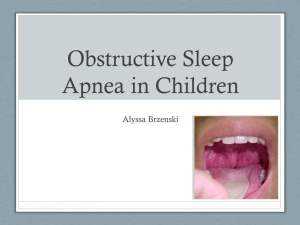

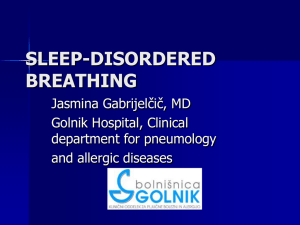
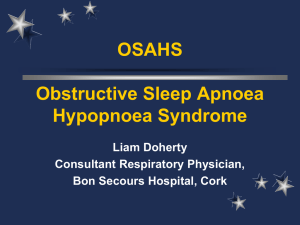
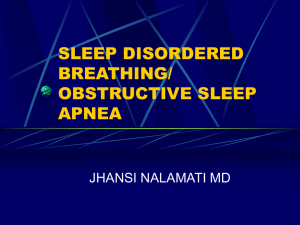
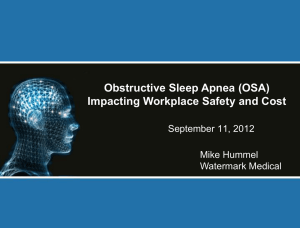
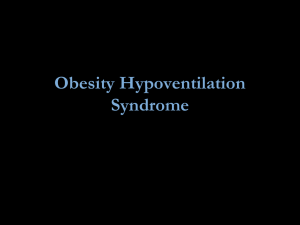
![%Old_\documentstyle[12pt,fullpage,aaai97,psfig]{article](http://s3.studylib.net/store/data/007497215_1-2a14670be8089f5a62979095f69a5ea5-300x300.png)